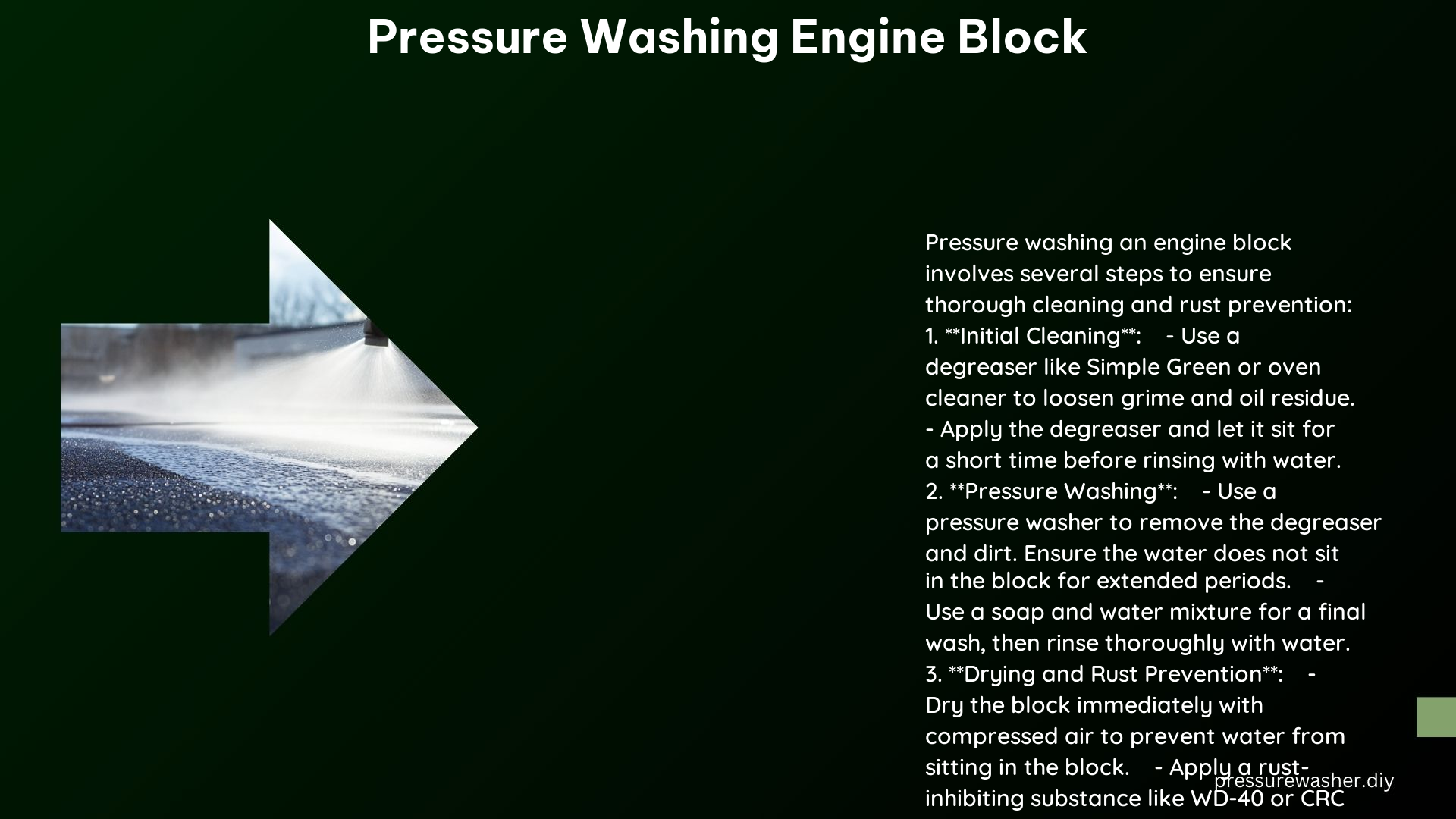Pressure washing an engine block can be a highly effective method for thoroughly cleaning and restoring the surface of the engine, but it requires meticulous attention to detail and a deep understanding of the process to avoid potential damage to the engine’s internal components. This comprehensive guide will delve into the safety considerations, preparation techniques, alternative cleaning methods, and technical specifications to ensure a successful and worry-free pressure washing experience.
Safety Considerations
Avoiding Water Ingress
One of the primary concerns when pressure washing an engine block is preventing water from entering the engine’s internal components, such as the cylinders, lifter valley, and crankshaft area. Water intrusion can lead to devastating consequences, including rust, corrosion, and damage to critical bearings and other parts. To mitigate this risk, it is essential to take the following precautions:
- Seal Critical Openings: Carefully seal off any openings or passages that could allow water to enter the engine, such as the spark plug holes, oil passages, and any other exposed areas. This can be done using high-quality masking tape, silicone sealant, or specialized engine-safe plugs.
- Protect Electrical Components: Ensure that all electrical components, including wiring harnesses, sensors, and connectors, are thoroughly protected from direct water exposure. Wrap them in plastic or use specialized covers designed for this purpose.
- Avoid High-Pressure Spraying: When pressure washing the engine block, use a wide-angle fan tip and maintain a distance of at least 12 inches from the surface. Avoid direct, high-pressure spraying, as this can force water into sensitive areas.
Immediate Drying and Rust Prevention
After the pressure washing process is complete, it is crucial to dry the engine block thoroughly and quickly to prevent the onset of rust and corrosion. Employ the following techniques:
- Compressed Air Drying: Use a high-powered air compressor to blow out any remaining water from crevices, bolt holes, and other hard-to-reach areas. This will help ensure a complete and thorough drying.
- Oil or Rust Inhibitor Application: Immediately after drying, apply a thin layer of engine oil or a dedicated rust inhibitor to all exposed metal surfaces. This will create a protective barrier against oxidation and corrosion.
- Timed Drying: Allow the engine block to air dry for a minimum of 30 minutes, or until you are confident that all moisture has been removed, before reassembling the engine or applying any additional coatings or treatments.
Preparation and Techniques

Engine Disassembly
For the most effective and thorough cleaning, it is recommended to disassemble the engine as much as possible before pressure washing the block. This will provide unobstructed access to all surfaces and help prevent water from entering critical internal components. Carefully remove the following components:
- Cylinder heads
- Timing chain or belt
- Oil pump
- Fuel system components
- Wiring harnesses and electrical connections
Cleaning Solution Selection
When it comes to the cleaning solution, it is best to opt for a mild, non-abrasive detergent. Harsh chemicals or acidic cleaners can potentially damage engine materials, such as aluminum or cast iron. Some recommended options include:
- Simple Green All-Purpose Cleaner
- Dawn Dish Soap
- Zep Engine Degreaser
Mix the cleaning solution with water in a ratio of approximately 1:10 (cleaner to water) for optimal effectiveness.
Brushing and Air Drying
In addition to the pressure washing, use soft-bristle brushes to scrub hard-to-reach areas, such as oil passages, cylinder walls, and other intricate surfaces. This will help dislodge any stubborn deposits or contaminants. After the washing and brushing, use high-pressure compressed air to thoroughly dry the engine block, paying special attention to bolt holes, crevices, and other areas where water may have accumulated.
Hot Water Considerations
While hot water can be used for the final wash, it is not an absolute necessity. Cold water can also be effective in removing dirt, grime, and other contaminants from the engine block. The key is to ensure that the water pressure and distance from the surface are properly adjusted to avoid water intrusion.
Alternative Cleaning Methods
Hot Tanking
For a more comprehensive and professional-grade cleaning, consider taking the engine block to a machine shop for hot tanking. This process involves submerging the block in a heated, chemical-based solution that effectively removes even the most stubborn deposits and contaminants. Hot tanking is often considered the gold standard for engine block cleaning, but it may be more time-consuming and costly than pressure washing.
Solvent-Based Cleaners
Some enthusiasts and mechanics recommend the use of solvent-based cleaners, such as GenClean or mineral spirits, for more aggressive cleaning of the engine block. These products can be effective in removing heavy grease, oil, and carbon buildup, but they may not be as environmentally friendly or safe for certain engine materials as the mild detergent solutions mentioned earlier.
Technical Specifications
Pressure Washer Settings
When pressure washing the engine block, it is crucial to use the appropriate settings to avoid water intrusion and potential damage. Adhere to the following guidelines:
- Pressure Setting: Start with a low pressure setting, around 1,000 PSI, and gradually increase as needed, but do not exceed 1,500 PSI.
- Nozzle Type: Use a wide-angle fan tip to distribute the water flow evenly across the surface, rather than a concentrated, high-pressure stream.
- Nozzle Distance: Maintain a distance of at least 12 inches between the nozzle and the engine block to prevent direct, high-pressure spraying.
Drying Time and Rust Prevention
After the pressure washing is complete, allow the engine block to air dry for a minimum of 30 minutes. This will ensure that all moisture has been removed from the surface and internal passages. Once dry, immediately apply a thin layer of engine oil or a dedicated rust inhibitor to all exposed metal surfaces to protect against corrosion.
References
- https://www.thirdgen.org/forums/tech-general-engine/739431-pressure-wash-open-engine.html
- https://www.reddit.com/r/EngineBuilding/comments/13vmum4/how_do_you_wash_an_engine_block/
- https://www.motortrend.com/how-to/engine-block-prep-cleaning/
- https://www.jalopyjournal.com/forum/threads/cleaning-an-engine-block-looking-for-a-cheap-alternative.696558/
- https://www.youtube.com/watch?v=mx5g_KO2PGg
